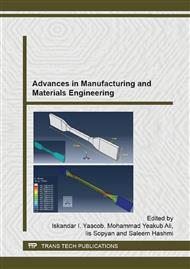p.300
p.304
p.308
p.317
p.321
p.325
p.331
p.337
p.341
Effect of Fibre Surface Treatment on the Properties of Eco-Core Sandwich Structures
Abstract:
The growing ecological, social and economic awareness, high rate of depletion of petroleum resources, concepts of sustainability and new environmental regulations have stimulated the search for green materials compatible with the environment. The focus of this research is to study the effect of fibre surface treatment as far as kenaf fibre composite sandwich structure is concern. The kenaf fibre is subjected to alkali treatment. Upon completion, the treated kenaf fibre is used for fabrication of composite sandwich structure by utilizing thermoset resin which is epoxy as the matrix and galvanized steel as the face skin. The sandwich structure undergone SEM for morphological study and three point bending test to identify the bending properties. Treated kenaf fibres shows improvement after the alkali treatment compared to untreated kenaf fibre in the composite sandwich structure.Keywords: Composite sandwich structures; biodegradable; kenaf fibres ; surface treatment; morphology
Info:
Periodical:
Pages:
321-324
Citation:
Online since:
July 2015
Authors:
Price:
Сopyright:
© 2015 Trans Tech Publications Ltd. All Rights Reserved
Share:
Citation:


